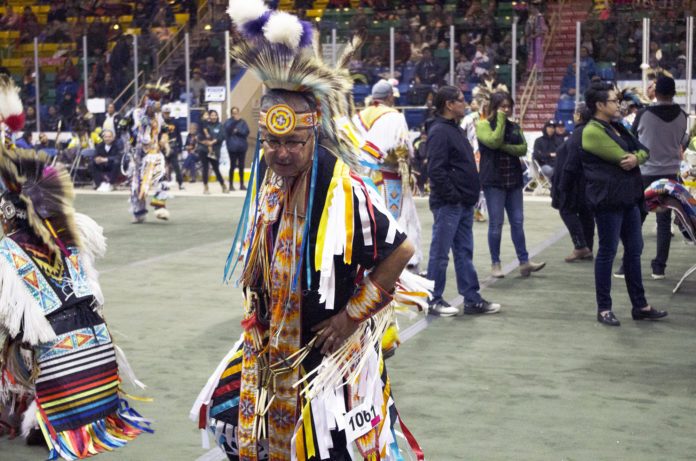
Harrison Thunderchild’s family is steeped in powwow tradition.
His father and grandfather were heavily involved in getting powwows going across Saskatchewan through the 1930s and ’40s and he continues that tradition today as a dancer. It’s not too often than he finds himself in a unique situation, but on Friday night, he did.
Thunderchild, along with his grandson Mitchell, were just two of the many dancers involved in the inaugural Generational Special dance at the Northern Lights Casino Thanksgiving Powwow.
“Last night was to show the younger generation, the grandchildren, to show them (the dance),” an exhausted Thunderchild said the next day. “Usually we talk to death. It goes in one ear and out the other.”
While dancing is often a form of celebration, the Generational Special has a different focus. The Northern Lights powwow committee created it as a way to honour the many missing and murdered Indigenous men and women across Canada, along with those who died during the Sixties Scoop. Grandparents were asked to dance with their grandchildren as a way to honour the mothers, fathers, sons and daughters who disappeared.
It’s an intensely personal dance for Thunderchild. His wife’s aunt is Christina Littlejohn, a 27-year-old from the Roseau River Reserve in Manitoba, who was seeing walking into the woods after a heavy day of drinking with a new boyfriend in 1968. She was never seen again and was declared legally dead in 1995.
“I cried,” an emotional Thunderchild said when asked about taking part in the dance with his grandson. “They came to me (to ask us to dance) and I cried.”
The idea for a Generational Dance isn’t that old. Powwow president Richard Ahenakew said the organizing committee began thinking about holding it only a month and a half before Thanksgiving.
Even though he didn’t dance himself, Ahenakew choked up when talking about the effect it had.
“It’s a very powerful and emotional dance that’s happening out there,” he said. “It’s tough to speak about it.”
Ahenakew said movements like Missing and Murdered Indigenous Women have had a significant impact on powwow volunteers and committee members. They wanted something that would help bring healing to people who had lost loved ones, while educating the next generation about the issue. They thought a special dance was a perfect idea.
“The easiest answer would have been, it’s part of the reconciliation process, but it goes even deeper than that,” Ahenakew explained. “We have a lot of our powwow committee, a lot of individuals who are influential in the powwow (circuit) and spent time helping us out over the 19 years we’ve been going, and they’ve lost family members. They’ve had family members not come back, and it’s something where we thought, ‘we need to do something.’”
For participants like Thunderchild, being a part of the dance was a difficult experience, but still an honour. He’s hopeful that it will help bring healing to those who are here, while remembering those who are gone.
“Each one of us are given a gift, and with that gift, we honour, and that’s what last night was,” he said. “It was an honour.”

